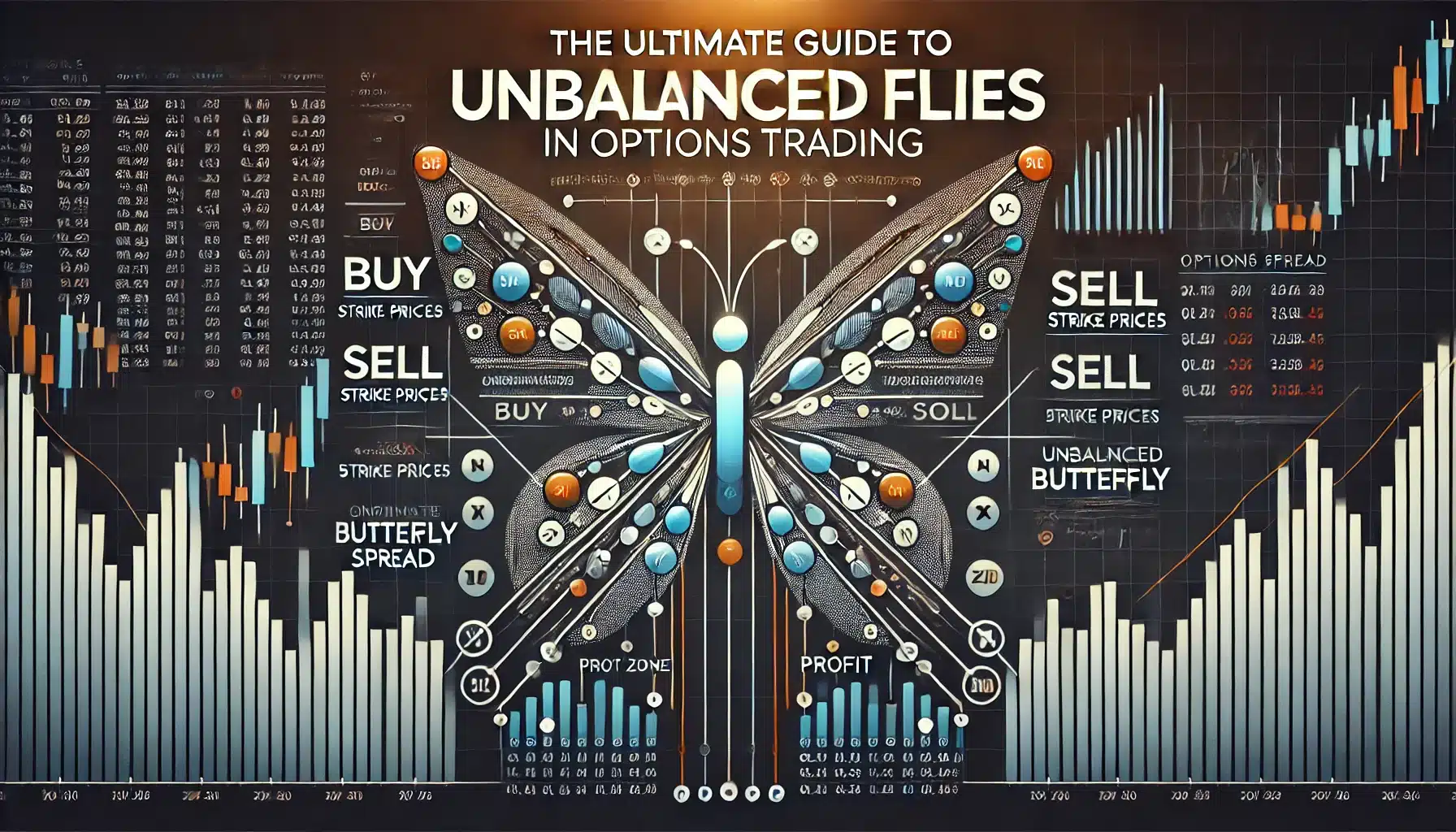The Ultimate Guide to Unbalanced Flies
The Ultimate Guide to Unbalanced Flies
Introduction to Unbalanced Flies

Introduction to Unbalanced Flies
Unbalanced flies, also known as unbalanced butterfly spreads, are advanced options trading strategies that provide traders with the opportunity to capitalize on market movements while effectively managing risk. These unbalanced flies can be highly effective, particularly in specific market conditions where other strategies might fall short. In this comprehensive guide, we will delve deep into unbalanced flies, explore how these unbalanced flies work, and discuss how you can use unbalanced flies effectively to enhance your trading strategy.
What Are Unbalanced Flies?
Defining Unbalanced Flies
Unbalanced flies are a variation of the traditional butterfly spread, which is a strategy that involves buying and selling options at different strike prices. In a standard butterfly spread, a trader buys one option at a lower strike price, sells two options at a middle strike price, and buys one option at a higher strike price. This creates a “fly” shape in the profit/loss diagram.
In unbalanced flies, the trader modifies the ratio of bought and sold options, creating an “unbalanced” structure. Typically, unbalanced flies involve buying one option at a lower strike price, selling two options at a middle strike price, and then buying another option at an even higher or lower strike price, resulting in an asymmetric position.
Why Use Unbalanced Flies?
Unbalanced flies offer several advantages over traditional butterfly spreads. They provide more flexibility in adjusting the risk/reward profile of a trade and can be tailored to suit specific market conditions. For instance, if a trader anticipates a significant move in the underlying asset but wants to limit potential losses, unbalanced flies can be a suitable strategy. This flexibility is why unbalanced flies have become a popular tool among seasoned traders.
Historical Context of Unbalanced Flies
The concept of unbalanced flies emerged as traders sought to improve upon the classic butterfly spread. While the exact origin is not well-documented, unbalanced flies gained popularity in the late 1990s and early 2000s as options trading became more sophisticated and traders looked for ways to fine-tune their strategies. The rise of electronic trading platforms made it easier for traders to execute complex multi-leg strategies like unbalanced flies, contributing to their increased use in modern trading.
How Unbalanced Flies Work
Constructing Unbalanced Flies
To construct unbalanced flies, a trader typically follows these steps:
- Buy One Option at a Lower Strike Price: This forms the lower wing of the unbalanced fly and provides some downside protection.
- Sell Two Options at a Middle Strike Price: This creates the body of the unbalanced fly and represents the area of maximum profit.
- Buy One Option at a Higher Strike Price: This forms the upper wing of the unbalanced fly, capping the profit potential while also reducing the initial cost of the trade.
In unbalanced flies, the trader may choose to buy or sell additional options at different strike prices to adjust the trade’s risk and reward profile, making it more aligned with their market outlook.
Example of an Unbalanced Call Fly
Suppose a trader believes that a stock currently trading at $100 will rise but not exceed $110. The trader constructs an unbalanced call fly as follows:
- Buy 1 call option with a strike price of $100.
- Sell 2 call options with a strike price of $105.
- Buy 1 call option with a strike price of $110.
- Sell 1 additional call option with a strike price of $115.
This creates a position where the trader benefits if the stock rises towards $105 but does not move significantly beyond that level. This example highlights how unbalanced flies can be tailored to specific market expectations.
Risk and Reward in Unbalanced Flies
The unbalanced fly strategy offers a unique risk/reward profile. The maximum profit occurs if the underlying asset’s price lands at the middle strike price (where the short options are located). The profit decreases as the price moves away from this point, with potential losses occurring if the price moves too far in either direction.
One of the key advantages of unbalanced flies is that they allow traders to adjust the risk and potential reward according to their market outlook. For example, adding more contracts at a higher strike price can reduce the cost of the trade but increase the potential downside if the trade moves against the trader.
Greeks and Unbalanced Flies
Understanding the Greeks is crucial when trading unbalanced flies. Here’s how the main Greeks affect unbalanced flies:
- Delta: Unbalanced flies typically start delta-neutral but become directional as the underlying price moves. The unbalanced nature allows traders to adjust the strategy’s delta sensitivity.
- Gamma: Unbalanced flies have positive gamma near the middle strike price, which can be advantageous in volatile markets.
- Theta: These strategies often benefit from time decay, especially as expiration approaches and the underlying price is near the middle strike.
- Vega: Unbalanced flies can be constructed to be either long or short volatility, depending on the trader’s market outlook.
When to Use Unbalanced Flies
Ideal Market Conditions for Unbalanced Flies
Unbalanced flies are best used in markets where the trader expects moderate price movements in the underlying asset. This strategy is particularly effective in scenarios where the trader has a directional bias but also wants to protect against significant adverse moves. Understanding when to use unbalanced flies can be the difference between a profitable and a losing trade.
Example: Earnings Season Strategy with Unbalanced Flies
During earnings season, stocks often experience significant volatility. A trader who anticipates a moderate rise in a stock’s price but wants to hedge against the risk of a significant decline might use an unbalanced fly. By adjusting the strikes and the number of contracts, the trader can create a position that benefits from a limited price increase while capping potential losses. This example shows how unbalanced flies can be adapted to specific trading situations.
Comparing Unbalanced Flies to Other Strategies
Compared to other options strategies like iron condors or standard butterfly spreads, unbalanced flies offer greater flexibility in adjusting the trade’s payoff structure. This makes unbalanced flies suitable for traders who want to tailor their positions to specific market conditions rather than taking on a more fixed risk/reward profile.
Unbalanced Flies vs. Iron Condors
While both strategies can profit from range-bound markets, unbalanced flies offer more flexibility in adjusting the risk profile. Iron condors have a wider profit zone but limited adjustment potential, whereas unbalanced flies can be fine-tuned to match specific price targets.
Unbalanced Flies vs. Standard Butterflies
Standard butterflies are symmetrical and typically have lower costs, but unbalanced flies allow traders to skew the risk/reward profile to match their market outlook. This makes unbalanced flies more versatile in different market conditions.
Advanced Techniques for Trading Unbalanced Flies
Adjusting Unbalanced Flies
One of the key benefits of unbalanced flies is the ability to adjust the position as the market evolves. Traders can add or remove contracts at different strike prices to shift the risk/reward balance or to respond to changes in the underlying asset’s price.
Example: Rolling an Unbalanced Fly
If the market moves significantly in one direction, a trader might “roll” the unbalanced fly by closing the existing position and opening a new one at different strike prices. This allows the trader to maintain a similar strategy while adapting to new market conditions. The ability to adjust unbalanced flies on the fly (pun intended) is one of the reasons why this strategy is favored by advanced traders.
Hedging with Unbalanced Flies
Unbalanced flies can also be used as part of a broader hedging strategy. For example, a trader with a large directional position might use an unbalanced fly to hedge against potential losses. By choosing strike prices and contract ratios that align with their existing positions, traders can create a hedge that offers protection without sacrificing too much profit potential.
Combining Unbalanced Flies with Other Strategies
Advanced traders often combine unbalanced flies with other options strategies to create complex, multi-leg positions that can handle a variety of market scenarios. For example, an unbalanced fly might be combined with a calendar spread to take advantage of both time decay and directional movement.
Example: Unbalanced Fly with a Calendar Spread
Suppose a trader expects a stock to rise over the next month but wants to profit from time decay in the short term. The trader might combine an unbalanced call fly with a calendar spread by purchasing long-term options and selling short-term options at the same strike prices. This creates a position that benefits from both directional movement and the decay of the short-term options’ time value. Combining unbalanced flies with other strategies allows traders to build positions that are more resilient to market fluctuations.
Risk Management in Unbalanced Flies Trading
Setting Stop-Losses
While unbalanced flies have defined maximum loss potential, it’s still crucial to set stop-loss orders. Traders might set stops based on:
- Underlying price movement
- Percentage loss of the initial investment
- Changes in implied volatility
Position Sizing
Proper position sizing is critical when trading unbalanced flies. Traders should consider:
- Account size
- Risk tolerance
- Potential maximum loss of the strategy
As a general rule, many traders limit their risk on any single trade to 1-2% of their total account value.
Monitoring and Adjusting
Active management is key to successful unbalanced flies trading. Traders should regularly monitor:
- Changes in the underlying asset’s price
- Shifts in implied volatility
- Time decay effects
Based on these factors, traders may need to adjust their positions by adding, removing, or rolling options to maintain the desired risk/reward profile.
Pros and Cons of Unbalanced Flies
Advantages of Unbalanced Flies
- Flexibility: Unbalanced flies can be tailored to fit specific market conditions and risk/reward preferences, making them versatile tools in the hands of experienced traders.
- Cost Efficiency: By selling additional contracts, traders can reduce the initial cost of the trade, making unbalanced flies more affordable to enter.
- Controlled Risk: The defined-risk nature of unbalanced flies helps traders manage their exposure to potential losses, offering a more controlled risk environment.
- Profit from Volatility: Depending on how they’re structured, unbalanced flies can profit from increases or decreases in implied volatility.
- Multiple Profit Scenarios: Unlike some directional strategies, unbalanced flies can profit in various market scenarios, depending on their structure.
Disadvantages of Unbalanced Flies
- Complexity: Unbalanced flies are more complex than standard strategies, requiring a deeper understanding of options and market conditions. This complexity can be a barrier for less experienced traders.
- Limited Profit Potential: The maximum profit is capped, which might not be suitable for traders looking for large gains. While unbalanced flies can generate consistent returns, they are not designed for traders seeking explosive profits.
- Adjustment Challenges: While adjustable, unbalanced flies require careful management and may need frequent adjustments as market conditions change. Traders must stay vigilant and be ready to modify their positions as needed.
- Execution Risks: With multiple legs, there’s a risk of partial fills when entering or exiting the trade, which can throw off the intended risk/reward profile.
- Higher Commission Costs: Due to the multiple legs involved, commission costs can be higher compared to simpler strategies, potentially eating into profits.
Implementing Unbalanced Flies in Your Trading Plan
Developing an Unbalanced Flies Strategy
To effectively use unbalanced flies in your trading, consider the following steps:
- Market Analysis: Develop a solid understanding of market trends, volatility patterns, and potential catalysts that could affect your chosen underlying asset.
- Strategy Selection: Based on your market analysis, choose the appropriate structure for your unbalanced fly. This might be bullish, bearish, or neutral, depending on your outlook.
- Risk Assessment: Determine the maximum risk you’re willing to take on the trade and size your position accordingly.
- Entry and Exit Planning: Decide on your entry points, profit targets, and stop-loss levels before entering the trade.
- Adjustment Criteria: Establish clear criteria for when and how you’ll adjust your unbalanced flies if market conditions change.
Backtesting and Paper Trading
Before risking real capital, it’s crucial to backtest your unbalanced flies strategies and practice through paper trading. This allows you to:
- Understand how the strategy performs in different market conditions
- Practice managing and adjusting positions
- Refine your entry and exit criteria
- Gain confidence in executing complex options trades
Continuous Learning and Improvement
The world of options trading is constantly evolving, and successful traders never stop learning. To improve your unbalanced flies trading:
- Stay informed about market trends and economic events
- Regularly review and analyze your trades
- Attend options trading seminars or webinars
- Engage with other options traders to share ideas and experiences
- Consider working with a mentor who has experience with advanced options strategies
Conclusion on Unbalanced Flies
Unbalanced flies are a powerful tool in the options trader’s arsenal, offering a unique blend of flexibility, risk management, and profit potential. By understanding unbalanced flies and how to use them effectively, traders can navigate complex market conditions with greater confidence. Whether you’re looking to capitalize on moderate price movements, hedge existing positions, or explore advanced trading strategies, unbalanced flies provide a versatile option for achieving your trading goals.
However, it’s important to remember that unbalanced flies are complex strategies that require careful planning, execution, and management. They are not suitable for all traders or all market conditions. As with any advanced trading strategy, it’s crucial to thoroughly educate yourself, practice extensively, and start with small positions as you gain experience.
Check out our articles on:
- Introduction to Options Trading
- Mastering Butterfly Spreads
- The Power of Diagonal Spreads
- The Power of Iron Condors
- The Power of Vertical Credit Spreads
Elevate Your Trading Skills
Ready to master the art of trading unbalanced flies and other advanced options strategies? Join our exclusive community of traders for in-depth educational resources, live trading sessions, and expert analysis. Sign up today and take your trading to the next level!
Remember, while unbalanced flies can be a powerful addition to your trading toolkit, they should be used as part of a well-rounded, risk-managed trading approach. Always consider your personal financial situation, risk tolerance, and trading goals when implementing any new strategy. Happy trading!
Below are the links:
To your success,

Billy Ribeiro is a renowned name in the world of financial trading, particularly for his exceptional skills in options day trading and swing trading. His unique ability to interpret price action has catapulted him to global fame, earning him the recognition of being one of the finest price action readers worldwide. His deep comprehension of the nuances of the market, coupled with his unparalleled trading acumen, are widely regarded as second to none.
Connect with us:






